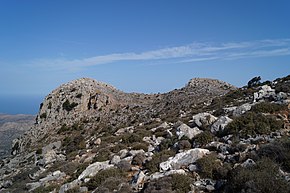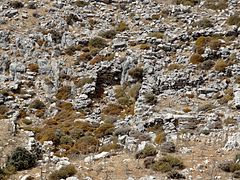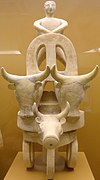Karphi
Karphi ( Greek Καρφί Karfi , 'nail') is the name of a late Minoan hilltop settlement on the western edge of the up to 1559 meter high Selena Mountains (Όρος Σελένα Oros Selena ) on the Greek island of Crete . The more than 250 × 450 meter large excavation site at an altitude of about 1110 meters is named after the summit of Mount Karfi , on which it is located directly on a southeast slope. The settlement remains are to the northwest of the Nisimos plateau (Οροπέδιο Νήσιμου Oropedio Nisimou ), about 7.5 kilometers south of the city center of Malia on the north coast of Crete and 2.5 kilometers northwest of Tzermiado .
history
The settlement remains of Karphi, which are difficult to recognize, are overgrown with low vegetation and exposed to erosion after they were excavated by archaeologists in the 20th century, including 1937 to 1939 by John Pendlebury . It is assumed that only about a third of the original development area has been excavated. In the Middle Minoan period (2000 to 1550 BC) there was probably a summit sanctuary here .
The development of the settlement with one-story houses, cobbled streets and a shrine with an altar is dated to the late Minoan period SM III C , the time of the " sea peoples storm ". Two cemeteries with Tholos graves were found near the place, in which there were probably around 3500 inhabitants at times , 17 small graves around the Vitzelovrysis spring and 4 near the Astividero spring.
The people lived from hunting, their herd animals and olive growing below the settlement. Richard Wyatt Hutchinson describes the year-round inhabited settlement in the mountains as a place of refuge, which was probably only chosen for reasons of defense, as the weather conditions there were obviously tougher than in the lowlands or on the coast of Crete.
The settlement existed until the post Minoan period. It was established after about two centuries around 950 to 900 BC. Abandoned BC. Ceramics found in the Karphi settlement are on display in room 11 of the Heraklion Archaeological Museum .
- Excavation site and find
literature
- HW Pendlebury, John DS Pendlebury, Mercy B. Money-Coutts: Excavations in the plain of Lasithi . III. Karphi: A city of refuge in the early iron age in Crete. Excavated by students of the British School of Archeology at Athens, 1937-1939. In: The Annual of the British School at Athens . No. 38 (1937/1938) , pp. 57-145 .
- Mercy B. Seiradaki: Pottery from Karphi . In: The Annual of the British School at Athens . No. 55 , 1960, pp. 1-37 .
- Krzysztof Nowicki: The history and setting of the town at Karphi . In: Studi Micenei ed Egeo-Anatolici (SMEA) . No. 26 , 1987, pp. 235-256 .
- B. Rutkowski: The temple at Karphi . In: Studi Micenei ed Egeo-Anatolici (SMEA) . No. 26 , 1987, pp. 257-279 .
- J. Wilson Myers, Eleanor Emlen Myers, Gerald Cadogan (eds.): The areal atlas of ancient Crete . University of California Press, 1992, ISBN 978-0-520-07382-1 , 15 Karphi, pp. 116–119 (English, limited preview in Google Book Search).
- Krzysztof Nowicki: Economy of Refugees: Life in the Cretan Mountains at the Turn of the Bronze and Iron Ages . In: Angelos Chaniotis (Ed.): From Minoan Farmers to Roman Traders . Sidelights on the Economy of Ancient Crete. Franz Steiner, Stuttgart 1999, ISBN 3-515-07621-2 , pp. 145–171 ( limited preview in Google Book search).
- Leslie Preston Day: Ritual Activity at Karphi: A Reappraisal . In: AL D'Agata, A. van de Moortel (Ed.): Archaeologies of Cult: Essays on Ritual and Cult in Crete in Honor of Geraldine C. Gesell . Princeton 2009, p. 137-151 , JSTOR : 27759937 (English, Hesperia. Supplement 42).
- Nancy L. Klein, Kevin T. Glowacki: From Kavousi Vronda to Dreros: Architecture and Display in Cretan Cult Buildings 1200-700 BC In: AL D'Agata, A. van de Moortel (Eds.): Archaeologies of Cult: Essays on Ritual and Cult in Crete in Honor of Geraldine C. Gesell . Princeton 2009, p. 153-167 , on Karphi pp. 158/159 (English, tamu.academia.edu [accessed December 27, 2011] Hesperia. Supplement 42).
Individual evidence
- ^ Esther Widmann: Ain't no mountain high enough: Man and the environment in the uplands of Crete from the Neolithic to the end of the Roman period . University of Heidelberg, 2014, Lasithi Plain, p. 250–253 (English, digitized version [PDF; 43.1 MB ; accessed on December 27, 2016]).
- ↑ Eberhard Fohrer: Crete . 18th edition. Michael Müller Verlag, Erlangen 2009, ISBN 978-3-89953-453-5 , p. 317 .
- ↑ Karfi. In: crete.tournet.gr. Retrieved December 26, 2011 .
- ↑ a b c Karphi. In: digiserve.com. July 7, 2008, accessed December 26, 2011 .
- ↑ S. Soetens, J. Driessen; A. Sarris, S. Topouzi: The Minoan peak sanctuary landscape through a GIS approach . In: François Djindjian, Paola Moscati (ed.): XIV Congress of the International Union of Prehistoric and Protohistoric Sciences (Liege - Belgium - September 2001). Commission IV. Data Management and Mathematical Methods in Archeology. Proceedings of Symposia 1.3, 1.5, 1.8, 1.10 (= Archeologia e Calcolatori . No. 13 ). All'Insegna del Giglio, Firenze 2002, ISBN 88-7814-215-8 , p. 161–170 ( preprint [PDF; 1.1 MB ; accessed on December 26, 2011]).
- ^ Karphi (site). Perseus Digital Library, accessed December 27, 2011 .
- ↑ Heraklion Archaeological Museum. Room 11: Subminoic and Early Geometric Period (1100–800 BC). In: crete.tournet.gr. Retrieved December 26, 2011 .
Web links
- Karfi. In: Digital Crete: Archaeological Atlas of Crete. Foundation for Research and Technology-Hellas (FORTH), Institute for Mediterranean Studies(English).
- Karphi. (PDF) Location and reconstruction. Heidelberg University, accessed on January 4, 2015 .
- Karphi settlement SM IIIC. Pictures of the settlement. minoer.net, accessed October 7, 2016 .
- Karphi. Minoan Crete, July 12, 2015, accessed October 7, 2016 .
- Karfi - Lassithi Plateau. www.andrewsenior.com, June 15, 2005, accessed December 26, 2011 .
- Catherine Morgan: Karfi. American School of Classical Studies at Athens, March 3, 2010, accessed March 5, 2018 .
Coordinates: 35 ° 13 ′ 3.3 " N , 25 ° 28 ′ 13.8" E





